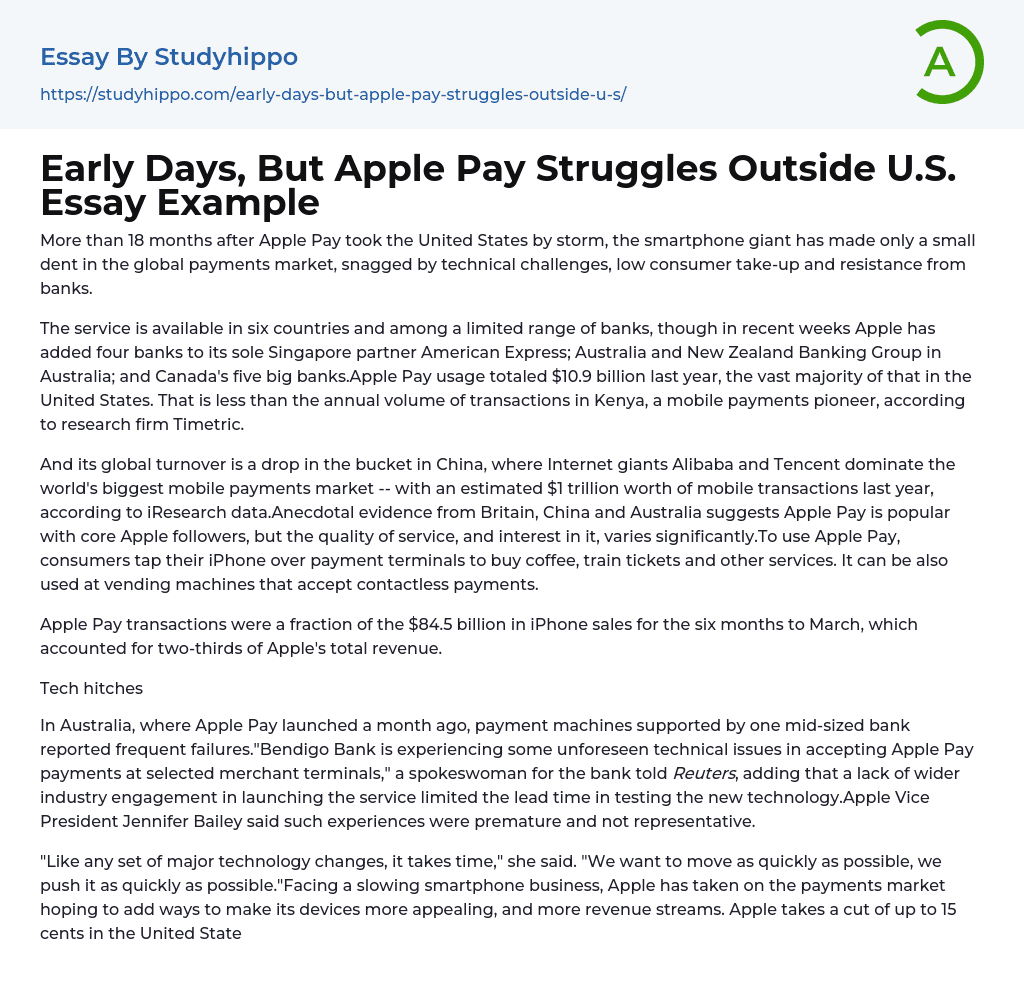Although Apple Pay has been thriving in the United States for more than 18 months, it has faced multiple hurdles when trying to secure a significant share of the global payments industry. Such impediments consist of technological glitches, limited acceptance among consumers and opposition from financial establishments.
Although only available in six countries with a limited number of banks, Apple Pay has broadened its partnerships by adding four new banks. The recent additions are Australia and New Zealand Banking Group from Australia, Canada's five major banks, and American Express from Singapore. Despite achieving $10.9 billion worth of transactions in 2016, predominantly from the United States; this figure is still less than Kenya's annual mobile payments volume - a leading country in mobile payment innovation according to Timetric.
According to iResearch data, Apple Pay has a smaller presence in the Chinese mobil
...e payments market compared to Alibaba and Tencent, who managed approximately $1 trillion worth of mobile transactions last year. While it is favored by loyal customers in regions such as Britain, China, and Australia, its popularity and service quality vary greatly. Despite its worldwide availability, consumers can use the system to purchase items like coffee, train tickets, and vending machine products by placing their iPhones over contactless payment terminals.
Apple's iPhone sales made up two-thirds of its overall revenue, reaching $84.5 billion for the six months leading up to March. Despite this, Apple Pay transactions only accounted for a fraction of that amount.
Tech issues
After the launch of Apple Pay, payment machines at one mid-sized bank in Australia experienced problems. According to Bendigo Bank's spokeswoman, these issues were due to technical difficulties and a lack of industry engagement. However
Jennifer Bailey, Vice President at Apple, disputed that these experiences were indicative or representative.
An Apple spokesperson stated that significant technological changes require a considerable amount of time and effort. Apple has ventured into the payments market to boost device appeal and revenue streams in light of decreased smartphone sales. In the United States, Apple gains 15 cents for every $100 spent. Despite efficiently managing the mobile device supply chain, managing the payment ecosystem has presented challenges. Reports indicate that global implementation of Apple Pay has been impacted as banks negotiate lower transaction fees abroad. Hardware upgrades have been made to accommodate new products like the Apple Watch and services like Apple Pay. From 2013 to 2015, research and development investments reached over $8 billion.
Opposition to Apple Pay
Local banks in Australia, Britain, and Canada are creating their own payment systems to compete with Apple's Pay service. This has posed resistance to Apple's efforts of promoting its payment service. Joshua Gilbert from First Annapolis Consulting states that the complexity of the system and the presence of numerous existing providers impede rapid innovative modifications.
The introduction of Apple Pay has been gradual, with the company slowly adding countries and partners to their service. However, this has resulted in an inconsistent banking landscape where users and retail staff are unsure of what will work and how. In the United Kingdom, $14 billion was spent using contactless cards in the past year, making it difficult for people to see the benefit of registering their cards with Apple Pay for the same convenience. According to Juniper Research analyst Windsor Holden, there are over 86 million contactless cards
in circulation in Britain. In countries like Australia, where contactless cards make up over 60% of all card transactions, reception to Apple Pay has still been lukewarm.
A spokesperson for a major retailer stated that there has been minimal usage of the payment option within their industry. Anonymity was preferred since the spokesperson lacked the authorization to speak publicly about the issue. Diego Machuca, aged 32, is a customer of Commonwealth Bank, which does not offer Apple Pay. He uses an iPhone and primarily handles transactions without paper money. Machuca appreciates Apple Pay but would not change his banking institution purely for its usage.
In an interview with Reuters, he expressed his belief that using Tap-and-go is not worth the effort. While popular fast-food chains have started accepting Apple Pay, it has not been as simple as other local services like WeChat - Tencent's messaging and mobile commerce platform. This was reflected in online forums three months after its launch in China. Despite this, Apple Pay's strategy has resulted in growth in markets where the mobile payments industry had previously been weak, giving it an edge over competitors such as Google's Android Pay and Samsung Pay.
Both the United States and Britain now have access to Android Pay on the latest model Android phones, while Samsung Pay is currently available in China, South Korea, and the United States. This information was reported by Matt Siegel in Sydney, Jeremy Wagstaff in Singapore, Eric Auchard in London, and the Beijing Newsroom; Ian Geoghegan handled editing.
- Commercial Bank essays
- Debit Card essays
- Deposit Account essays
- Subprime Lending essays
- Adidas essays
- Amazon essays
- Apple essays
- Bmw essays
- British Airways essays
- Burger King essays
- Coca-Cola essays
- Company essays
- Costco essays
- Dell essays
- Ebay essays
- Enron essays
- Facebook essays
- Ford Motor Company essays
- Gap essays
- General Motors essays
- Google essays
- Honda essays
- Ibm essays
- Ikea essays
- Intel essays
- Iphone essays
- Johnson and Johnson essays
- Kellogg essays
- Key essays
- Kfc essays
- Mcdonald's essays
- Microsoft essays
- Myspace essays
- Nestle essays
- Netflix essays
- Nike essays
- Nokia essays
- Pepsi essays
- Pepsico essays
- Red Bull essays
- Ryanair essays
- Samsung essays
- Sony essays
- Southwest Airlines essays
- Starbucks essays
- Supermarket essays
- Tesco essays
- Toyota essays
- Twitter essays
- Volkswagen essays




